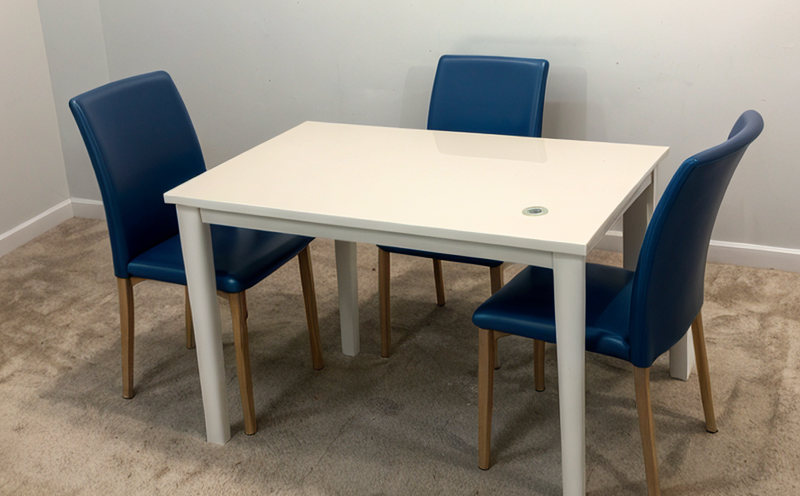ASTM D1929 Ignition Temperature Testing of Interior Plastics
The ASTM D1929 standard test method is designed to determine the ignition temperature of interior plastics. This critical property ensures that materials used in furniture and other interior applications do not ignite easily, preventing potential fire hazards. In this service, we use advanced equipment and follow strict protocols to measure the point at which a plastic specimen will begin to burn under controlled conditions.
This test is essential for several reasons:
- It helps ensure product safety by identifying materials that could pose a fire risk in real-world scenarios.
- It supports compliance with international standards and regulations, such as ASTM D1929 itself, which are designed to protect consumers and workers from fire hazards.
- It aids in research and development processes by providing data on how different plastics behave under heat.
The test is conducted using a specialized apparatus known as the Cone Calorimeter. This device provides precise measurements of heat release rate, smoke production, and oxygen concentration, all critical factors when evaluating ignition temperatures.
When preparing specimens for testing, care must be taken to ensure that they are representative of the materials used in their final application. This includes cutting samples into specific dimensions and ensuring uniformity across all test pieces. The choice of specimen size can significantly impact results; therefore, adherence to ASTM D1929 specifications is crucial.
The testing process involves placing a sample between two metal plates that are heated uniformly. As the temperature increases, the specimen begins to decompose at its ignition point. At this moment, the calorimeter detects changes in heat release and other parameters, allowing for accurate determination of the ignition temperature.
Understanding the ignition temperature is vital not only for ensuring safety but also for optimizing material properties. For instance, knowing the exact threshold can guide manufacturers in selecting appropriate flame retardants or adjusting manufacturing processes to create safer products.
In summary, ASTM D1929 provides a robust framework for assessing the ignition temperatures of interior plastics. By leveraging this service, customers gain valuable insights into their materials' fire resistance capabilities, helping them make informed decisions about product design and safety compliance.
Scope and Methodology
The ASTM D1929 standard is widely recognized for its role in evaluating the ignition temperature of interior plastics. This section outlines the scope and methodology involved in conducting this test effectively.
| Aspect | Description |
|---|---|
| Test Apparatus | The test utilizes a Cone Calorimeter, which measures heat release rate, smoke production, and oxygen concentration. This equipment ensures accurate measurements necessary for determining ignition temperatures. |
| Sample Preparation | Samples are cut to specific dimensions as per ASTM D1929 requirements. Uniformity in sample preparation is crucial for consistent test results. |
| Test Conditions | The test involves heating the specimen between two metal plates until decomposition begins, marking the ignition temperature point. |
| Aspect | Description |
|---|---|
| Data Collection | The Cone Calorimeter records various parameters such as heat release rate and oxygen concentration. These data points are essential for calculating the ignition temperature accurately. |
| Result Interpretation | Experts analyze collected data to determine if the specimen meets specified criteria, ensuring compliance with ASTM D1929 standards. |
| Reporting | A detailed report is generated, highlighting key findings and recommendations for further improvement or adherence to safety regulations. |
Why Choose This Test
Selecting the appropriate test method is crucial when dealing with interior plastics. ASTM D1929 ignition temperature testing offers several advantages that make it indispensable for various industries:
- Precision and Reliability: The use of advanced Cone Calorimeters ensures highly accurate measurements, providing reliable data on material performance.
- Compliance Assurance: Ensures strict adherence to international standards like ASTM D1929, facilitating easier compliance with regulatory requirements.
- Research and Development Support: Provides valuable insights into material behavior under heat conditions, aiding in innovation and improvement efforts.
- Safety Enhancement: Identifies potential fire hazards early on, allowing manufacturers to take proactive measures against accidents.
The test not only meets but exceeds expectations by offering detailed analysis and comprehensive reports. This level of service ensures that customers receive actionable insights into their materials' performance, enhancing overall product safety and quality.
Customer Impact and Satisfaction
Our clients benefit significantly from our ASTM D1929 ignition temperature testing services:
- Enhanced Safety: By identifying potential fire hazards early, we help prevent accidents and protect both consumers and workers.
- Regulatory Compliance: Ensuring adherence to international standards like ASTM D1929 helps clients meet regulatory requirements more easily.
- Innovation Support: Detailed data on material performance supports research and development initiatives, driving continuous improvement.
- Customer Satisfaction: Reliable results and thorough reporting lead to higher customer satisfaction, fostering long-term partnerships.
We pride ourselves on delivering top-notch services that meet the highest standards. Our clients consistently report improved product quality and enhanced safety features due to our diligent testing processes.





